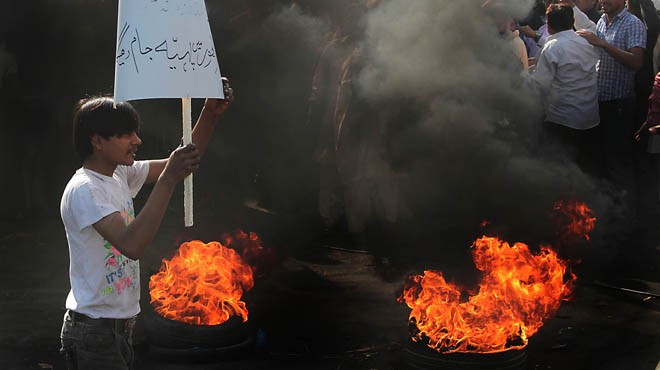
Huge line losses and circular debt mar the power sector as massive load shedding haunts the people

It would be difficult to assess the PML-N government’s performance in the power sector or even say that the performance is a mixed bag. Most indicators show that it’s largely poor. Line losses are over 24 per cent, circular debt has again swelled to over Rs285 billion, and receivables of power sector have alarmingly increased to over Rs525 billion while recovery of bills has also not been up to the mark.
As a consequence, a massive load shedding is haunting the people.
Instead of managing the power distribution companies (Discos) and electricity generation companies (Gencos), the government has increased power tariff by 33 per cent in one year. Even then, it has failed to improve the financial health of the power sector.
The government further decided to recover from consumers the loans of Rs250 billion the Discos have got so far. This decision alone will also increase power tariff by Rs 5 per unit.
A critical step taken by the government in the budget 2014-15 is the huge reduction in subsidy to the consumers to the tune of Rs80 billion -- from Rs245 billion to Rs156 billion -- owing to which the tariff has also increased manifold.
A year ago, the government paid the circular debt of Rs501 billion that helped inject additional 1700MW in the system. The power outages reduced significantly, but the pleasant change happened to be short-lived as the government did not come up with any mechanism to avoid the re-emergence of the circular debt.
After one year, circular debt has again appeared and currently stands at over Rs285 billion. Out of this, the government has to pay Rs210 billion to the Independent Power Producers (IPPs), which are now underperforming on account of non-availability of liquidity and generating less electricity by about 1,700MW, the same volume of electricity the government had injected in the system a year back after paying circular debt.
The people were shocked to hear Minister of Water and Power, Khawaja Asif, on July 14, admitting his failure in providing the required electricity to the masses. The minister also conceded that the government’s emphasis had been on electricity supply side but not on managing the demand side and upgrading the below 220KV transmission system.
The question is that why did the government not adopt an integrated policy to resolve the power crisis? The answer perhaps is that various power centres, from within the government as well the cronies who are said to have stakes in the power sector, continue to intervene in the affairs of the ministry of water and power.
Nargis Sethi, secretary water and power, says the system is dilapidated and is not strong enough to shoulder the load of over 15,000MW. However, it is interesting to note that on June 28, 2013, the same system picked the load of 16,100MW and the system did not collapse.
According to an official in the ministry dealing with transmission system, if the government wants to reduce the electricity breakdowns hours, it will have to upgrade the existing below220KV transmission system of electric distribution companies.
If we want to reduce load shedding, the authorities will have to lay down a transmission system that could absorb the demand of electricity that is to stand after 4-5 years time. The system is facing 10-12 per cent growth in electricity demand every year and the transmission system is not being synchronised with increased pace in electricity demand.
The top officials of the Discos also attribute the current power crisis, particularly in Punjab, to infighting between the engineering cadre in the Discos and the officials of district management group in the ministry. The recent arrest of LESCO Chief and Director Operation, and death of two officials of Multan Electric Power Company because of heart attack (apparently on account of pressure from Islamabad during daily video conferences) have intensified the tension. This is why the discos officials are not cooperating with the Nawaz government in coping with the power crisis.
Coming to short-term solutions, the government is left with no option but to take conservation measures. It could save about 1500-2000MW of electricity a day by closing down the markets at 8pm. But the Nawaz government did not want to annoy the trading community which is a source of its strength.
The PPP government had attempted to install the Rental Power Plants but the Supreme Court struck down the RPPs deal. Now the Nawaz government wants to introduce the short-term IPPs with some modifications. The RPPs that would be cleared from NAB would also be considered as short-term solution.
As far as long-term solutions are concerned, Pakistan needs to focus on improving the electricity supply side by increasing hydro-generation, coal-based power generation, and nuclear power generation. In addition, the government should also exploit the wind and solar potential the country has.
If we look at the system losses, there is no improvement at all. The losses in Pakistan’s power sector are more than total of the combined installed capacity of Afghanistan, Sri-Lanka, Nepal and Bhutan.
The myth that the electricity losses are on the rise in KPK, Sindh and Balochistan is proven wrong as the data collected through the smart metering system installed with the help of USAID in 2010 has divulged that the electricity losses in Punjab are more than the electricity consumption of the whole Balochistan.
Energy expert, Arshad H Abbasi, says Punjab’s annual consumption of electricity stands at 47 billion units out of which 4.7 billion units get wasted and stolen which is more than the whole consumption of Balochistan that stands at 3.9 billion units.
Likewise, the electricity consumption of Sindh, other than Karachi, stands at 7.9 billion units. In KP, the electricity consumption is at 8.9 per cent.